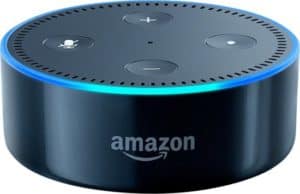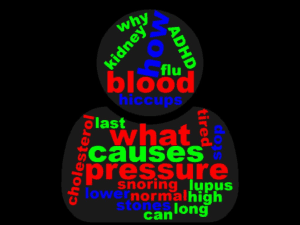“Hey, Alexa – What’s the protocol for follicular neoplasm?”
“Speaking is the new typing,” as MediaPost recently declared. For docs and healthcare marketers who spent beaucoup funds in assembling online interactive diagnostic peer-reviewed databases, there’s now a new question: is your online content optimized for voice?

The voice revolution is underway
With 35 million Americans presently using voice-activated assistants (and that number grows daily), increasing numbers of potential patients today often self-diagnose by simply asking their Amazon Echo or other voice device. The self-diagnosis can quickly lead to a hospital brand, as New York’s Northwell Health’s Emergency Room knows. They offer a highly competitive voice-optimized “wait times” function that shows to prospective patients wanting to now – in real-time – how long they might have to wait to be seen in an emergency room.
Comfort grows for diagnostic voice searches
A key fact? Today’s patients and family members increasingly turn to personal assistants such as Alexa and Siri for self-diagnostic or background medical information (including looking up the Google star rating bona fides for physicians, clinics and hospitals). A number of experts predict that voice technology will fundamentally transform healthcare experience.
And it’s already happening. Voice-assisted searches nearly-instantly locate and serve up healthcare answers that prospective patients crave. Why is this important? Research from ComScore indicates that a full 50% of all online searches will be voice searches within the next 24 months!
The good news is that we’re still in the early days for voice, but now is the time to hustle! Given that, how can you optimize your content to be found by their powerful voice search engines and elevate your brand? On the technical side, a look at specific APIs and interaction models is important. Plenty of online resources exist for Amazon Echo, Siri and Cortana can help you enhance the platform you will need to reach your voice-activated target market (think mobile-friendly).
But make no mistake: the critical issue is conversational, natural, highly relevant content. Since Google’s Hummingbird update hit the internet world, semantic search capability became both possible and critical.
Here’s an important point: people generally don’t talk the same as how they type. your future voice-optimized search function, let’s consider some important steps in creating content.
Keep it natural and conversational
The key to marrying content with voice searches lies in natural language.
Natural language calls for real-life speech patterns – the way we instinctively communicate daily. Consider a handful of these recent top ten Google health searches from Harvard’s Dr. Google:
• What causes hiccups?
• What can I do to stop snoring?
• What causes kidney stones?
• Why am I so tired?
• How long does the flu last?
Siri, Echo and Alexa will deliver direct, easy-to-understand AI-driven answers to all of the above. How can you leverage content so your hospital, clinic or practice is a player in this game?

Useful Patterns You Should Obsess Over
Some distinctive patterns exist that present clues to effective content. Perhaps you identified the following:
• Express searches as questions
• The majority of the questions begin with the word what
• Why and how make for good opening words, too
Though not obvious from the examples above, beginning a search with the phrase how to, as in “how to lower cholesterol,” turns out to be another habitual pattern.
When Alphabet Soup Is Not So Fun
Serving clear broth to a toddler can be a dreadful experience. But bring in alphabet-shaped noodles and – BINGO – that little element of fun transforms boring clear broth into something interesting to a child’s mind.
But conversely, “alphabet soup” that appears in clinical notes, specifically the heavy use of acronyms and abbreviations, often obscures clear understanding among patients. It gets worse, even unusable, in voice-activated marketing messages. Simply put, healthcare “alphabet soup” poses a major challenge to natural language and voice optimization. So, think about that when your team is assembling critical content.
Terms with dual meanings act as stumpers, too. Consider the words discharge and cold. Imagine the potential frustration for an anemia patient suffering from excessive blood loss (discharge) who searches for pragmatic information related to the condition but receives instructions related to exit (discharge) forms and procedures. Or, picture a possible flu patient who complains of being cold vs. having a cold.
Hurdles Are Harmless – Manage Easily and Absolutely
Natural language processing technology moves quickly. But, in the dual meaning examples shared above, managing these shortcomings compared to what the human brain interprets – well, it’s not quite there. In spite of such hurdles, acronyms, abbreviations, and dual meaning words are both manageable and harmless in the arena of voice-optimized healthcare content marketing.
For instance, well-known acronyms like the CDC pose no problem for voice-optimized searching. But, avoid acronyms that lack uniqueness. Take IPA for example. A voice search for the healthcare organization Independent Practice Association will return better results when speaking the full name rather than the acronym. Though it might be humorous, using IPA alone brings back unrelated results in the form of International Phonetic Alphabet and India pale ale.
Linking medical specialties and provider names rank among two more conceivable barriers. However, they are straightforward and relatively easy to overcome – if you have the right focus.
Where to start? Don your patient cap. Then suppose that you are searching for ENTs in your county. Assume that the nearest and highly rated ENT is five miles from your home. The challenge deepens: the healthcare website for that ENT lists that doctor’s services under otolaryngology. Otolaryngology? If you have to look up otolaryngology or you read over it because that word has never cruised across your mind, then “Houston, we have a [healthcare content marketing] problem.”
Here’s the simple solution to this stumbling block: list the common name beside the technical medical term.
• Gastroenterology (stomach/intestines)
• Cardiology (heart)
• Oncology (cancer)
• Podiatry (foot)
• Pulmonology (respiratory)
The patient health literacy topic necessitates time spent on explaining terminology and easing anxiety due to misunderstanding. When it comes to voice optimization and content marketing, focus on taking advantage of the “easy” button.
The need to create easy-to-access-and-understand content (and programming) for voice optimization is already here. The growing adoption of voice-activated services is likely only to increase. So, write naturally, publish with clear intent, help your listeners (and readers) find critical topics with ease, keep your Google My Business page up-to-date, and await the positive results in your patient’s journey online!
